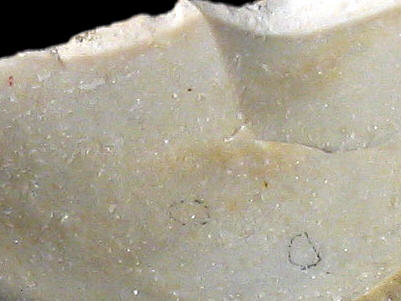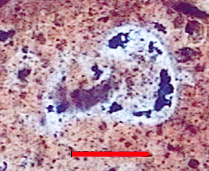
Foto: Jehanne Féblot-Augustins, 2005.
- Chatanay
Sampled sites:
| Material name: | CN6 |
| Synonyms: | Silex Crétacé supérieur Nord - Sénonien (Campanien) |
| Material (geologic): | Late Cretaceous (Senonian, Campanian) flint |

Foto: Jehanne Féblot-Augustins, 2005. |
Sampled sites:
|
| Mode of occurrence: | Entirely patinated nodule fragment (cream-coloured patina). |
| Cortex: | Remaining cortex is thin and worn, smooth, stained yellowish red, and highlighted by a white 1 cm thick desilicified band forming a sharp transition with the flint. |
| Colour: | Light grey (2.5Y N6.5/2). |
| Pattern: | Featureless. |
| Appearance: | Homogeneous, dull and opaque, a little rough, medium-grained. |
| Structure: | No particular structure. |
| Texture: | Wackestone. |
| Matrix: | Opaque. |
| Grains: | 15 to 20 %, white or more seldom stained yellow by iron oxides, rounded with high to medium sphericity, contained between 100 and 250 µ. |
| Grain composition: | frequent thin-walled monaxon spicules, less frequent triaxon spicules, numerous globose planktonic foraminifera (e.g. Hedbergella ?), some benthic foraminifera (Lenticulinea), ostracods and bryozoan fragments; abundant ligneous debris, a few iron oxides. |
 Globotruncanidae (Hedbergella ?) in a CN4c flint type. Highly silicified. |
||
|
Photo: A. Arnaud Vanneau, (Laboratoire de Géodynamique des Chaînes Alpines, Grenoble) Determination: M. Caron, Université de Fribourg. |
| Further information: | Click here for the original French description (opens in a new window), or here for more information on the attributes used in the description (use your browser's "BACK"-button to return here). |
| Citing: | Information on citing this page can be found here. |
| Locality: | Poncin / Chenavel - Chatanay, France, Ain department |
| Synonyms: | Sampling site Bugey 48 after Féblot-Augustins |
| Geographical description: | The sampling-site is located directly adjacent to a narrow road, a bit over a kilometre to the (S)SW of Poncin. |
| Geographical co-ordinates: |
east/x 836,7 to 836,8 north/y 2124 to 2124,2 (Lambert zone II, NTF)
This corresponds roughly with |
| Co-ordinate precision: |
As the site is a few hectares in size, precision is not of the highest importance, but the coordinates lie well within the area. The geographical coordinates point to a spot near the centre of the site. The location can be found on the 1:25 000 topographical map sheet 3230 W of the French Institut Géographique National. |
| Geology: |
The material from this site can be classified as surface-collected flint or in eroded gulleys, Chenavel sector, clays-with-flint of various geological origins (Early and Late Cretaceous); Unit S (Rs). Map of all sampled localities of Late Cretaceous flint in the Bugey (PDF, 54 KB, opens in new window). |
| Type of source: | Secondary. |
| Other types of flint: | Besides the Campanian CN1a material, several types of Late Cretaceous material can be found here (CN1a, CN2a, CN2c, CN4a and CN4b), as well as Early Cretaceous Ht3 flint. |
thumb.jpg) Foto: Jehanne Féblot-Augustins, 2005 |
| Last modified on: November 15, 2005 |
Contents primarily by: Jehanne Féblot-Augustins |
Comments to: |